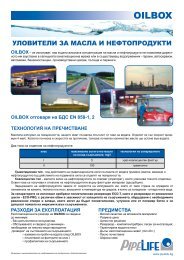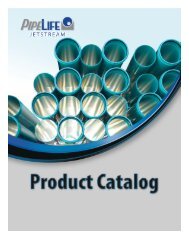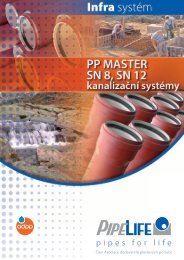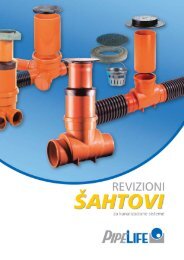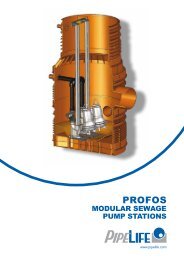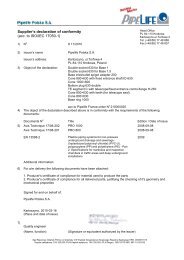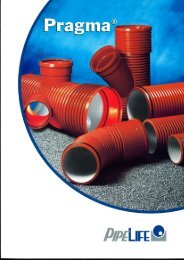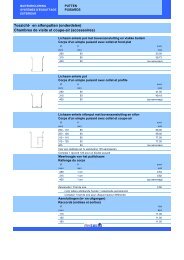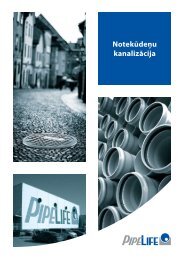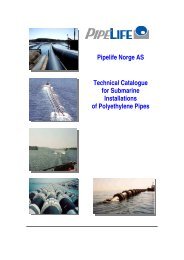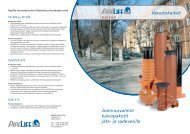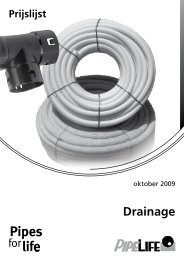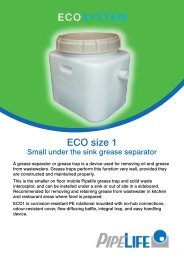Create successful ePaper yourself
Turn your PDF publications into a flip-book with our unique Google optimized e-Paper software.
10.4 Necessary data for statistical calculation of the PRAGMA ® pipe system<br />
With regard to the correct laying and exploitation of the sewage <strong>pipes</strong> of the <strong>Pragma</strong> ® system it is important to calculate the impact<br />
of the static and the dynamic pressure. For this purpose it is necessary to take into account the soil’s type, the availability of subterranean<br />
waters, the degree of covering sealing according to Proctor. The calculation can be made with the Pipelife’s web software in<br />
the “For the designer” section” on www.pipelife.bg.<br />
Also Pipelife possesses a EASYPIPE software which if necessary can make more detailed calculated statistics of the laid <strong>pipes</strong>. Both<br />
programs are based on the methodology for statistical calculation of <strong>pipes</strong> laid in the ground according to ATV 127. For the preparation<br />
of this calculation by the Pipelife’s engineering team it is necessary to submit the following data:<br />
Project data<br />
Data about the soil<br />
around and in the<br />
excavation zone<br />
Project<br />
Client<br />
Designer<br />
Date<br />
Basic soil groups<br />
G1 - not connected<br />
G2 - weakly, slightly connected<br />
soils<br />
G3 - mixed connected<br />
soils, coarse, raw clay<br />
(blocked with slime, sand,<br />
sand with big particles<br />
and fine gravel, connected<br />
deposit stone soils)<br />
Zones (Figure 10.5)<br />
E1 E2 E3 E4<br />
Data about the<br />
pressure<br />
Surface<br />
G4 - connected (e.g. clay)<br />
h – Height of covering above the pipe’s crown, [m] (Figure 10.6)<br />
Soil’s density for covering, [kN/m 3 ]<br />
Additional static pressure (for example when storing), [kN/m 2 ]<br />
H w max – maximal level of subterranean waters above the pipe’s crown, [m] (Figure. 10.7)<br />
H w min – minimal level of subterranean waters above the pipe’s crown, [m] (Figure 10.7)<br />
Short-term internal pipe’s pressure, [bar]<br />
Long-term internal pipe’s pressure, [bar]<br />
Traffic pressure (mark one of the following cases)<br />
Traffic frequency<br />
Regularly Irregularly<br />
LT12 – 12 tons - 2 (semi)axes<br />
HT26 – 26 tons - 2 (semi)axes<br />
HT39 – 39 tons - 3 (semi)axes<br />
HT60 – 60 tons - 3 (semi)axes<br />
First layer<br />
Second layer<br />
Thickness<br />
h 1 , [m]<br />
Elasticity module<br />
E 1 , [MPa]<br />
Thickness<br />
h 2 , [m]<br />
Elasticity module<br />
E 2 , [MPa]<br />
Laying<br />
Embankment<br />
/<br />
Excavation<br />
Excavation width above the pipe’s crown - b (м) - (from 0,1 up to 20 м)<br />
Excavation angle of repose - β (degrees)<br />
Conditions of the excavation from group A1 A2 A3 A4<br />
A1 to A4 (see types of groups at the end)<br />
Conditions of the bedding layer fro group B1 B2 B3 B4<br />
B1 to B4 (see types of groups at the end)<br />
Type of bedding layer<br />
Angle of laying -2α<br />
60° 90° 120° 180°<br />
Sand cushion<br />
Concrete bedding layer<br />
Pipelife<br />
www.pipelife.com<br />
28



